Our 2020 Toyota Supra 3.0 Had a Rough Winter
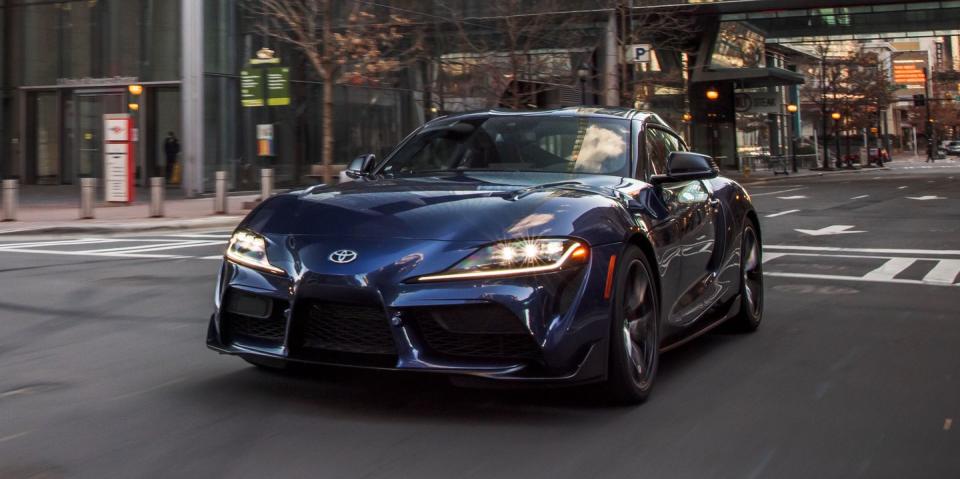

20,000-Mile Update
Spring daffodils have popped up, good driving weather has returned to Michigan, and we've swapped the winter tires on our long-term Supra for its original-equipment Michelin Pilot Super Sport summer rubber. We're now back to enjoying this raucous two-seater the way Toyota intended. If only the winter months with it had been this enjoyable.
As much as we love our joint-venture Toyota-BMW sports car, it would have been much happier wintering somewhere warmer and sunnier than in the snowy Midwest. (The same goes for most of us.) We have no issues with driving sports cars in winter; we've always done so with our long-termer vehicles after fitting them with winter tires, most recently with a Corvette, a Porsche, a Miata, and a Mustang. But those cars never gave us the kind of trouble that we experienced with our Supra, which largely can be explained in two words: ground clearance, of which the Supra 3.0 has but 4.5 inches.

Our Supra's cold-weather shoes comprise a quartet of rare and expensive Pirelli Sottozero Serie II tires specifically designed for sports-car use. The rears were originally developed for the Aston Martin DB9, while the fronts were engineered for the Lamborghini Aventador. However, their soft compound and extra grip in cold and slush weren't enough when white stuff piled up and packed itself under the Supra's low-slung underbelly. "This car is an absolute disaster in deep snow," reported staff editor Annie White. "It gets stuck very easily, and you then have to dig out the whole underbody before you can move again. I got stuck three times in the span of an hour and eventually figured out that if I just drove faster I could power through areas of built-up snow—which is more fun. But still, not good."
Staff editor Colin Beresford had a similar experience during three snowy days that he had the Supra. "I only got stuck three times," he said, "which I'm considering a win." Added White, "I get that this isn't a snow car, and I still love it, but people who want this to be their only car and who live in a snowy area should be prepared for massive inconvenience."
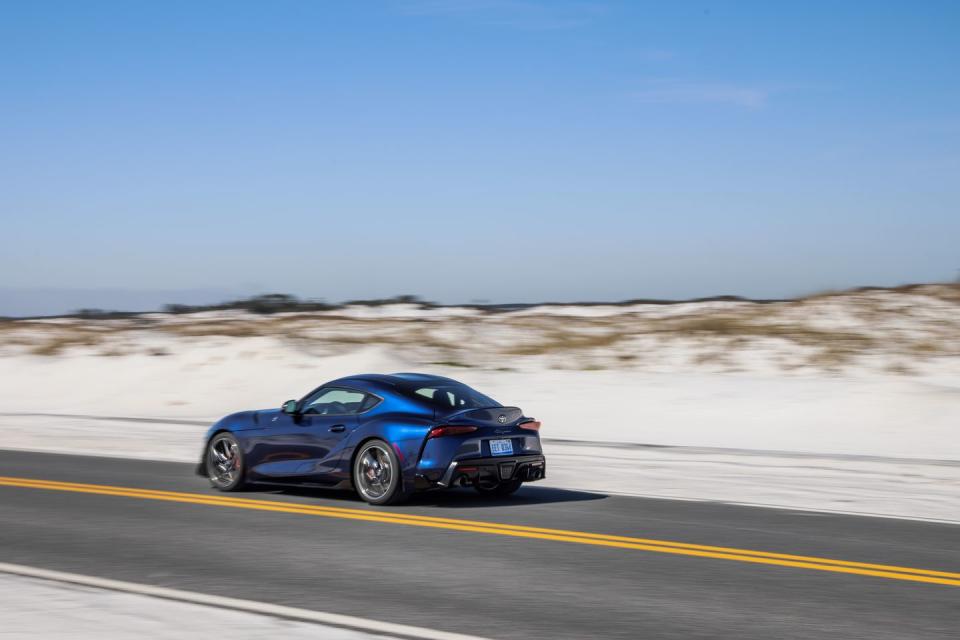
Thankfully, there were many more days during our most recent winter where the roads were clear and the Supra was able to remind us of what a thrilling and otherwise livable performance car it is. In fact, in these conditions the Sottozeros actually made life in sub-freezing temperatures better. Ultra-high performance summer tires like the Supra's standard Michelins are notoriously temperature sensitive. Once the thermometer dips close to freezing, their grip drops precipitously until they've been warmed up by several miles of driving—or more, depending upon how cold it is. Until the Michelins' temperatures came up, setting off with even a moderate prod of the Supra's accelerator spun the rear tires as if they were on ice, triggering abrupt intervention from the stability control.
The Sottozeros, on the other hand, amazed us with how much power they could put down in a straight line even when freezing cold. They also helped the Supra to steer and stop so well on dry pavement that the car's sharp-edged handling seemed hardly affected at all.
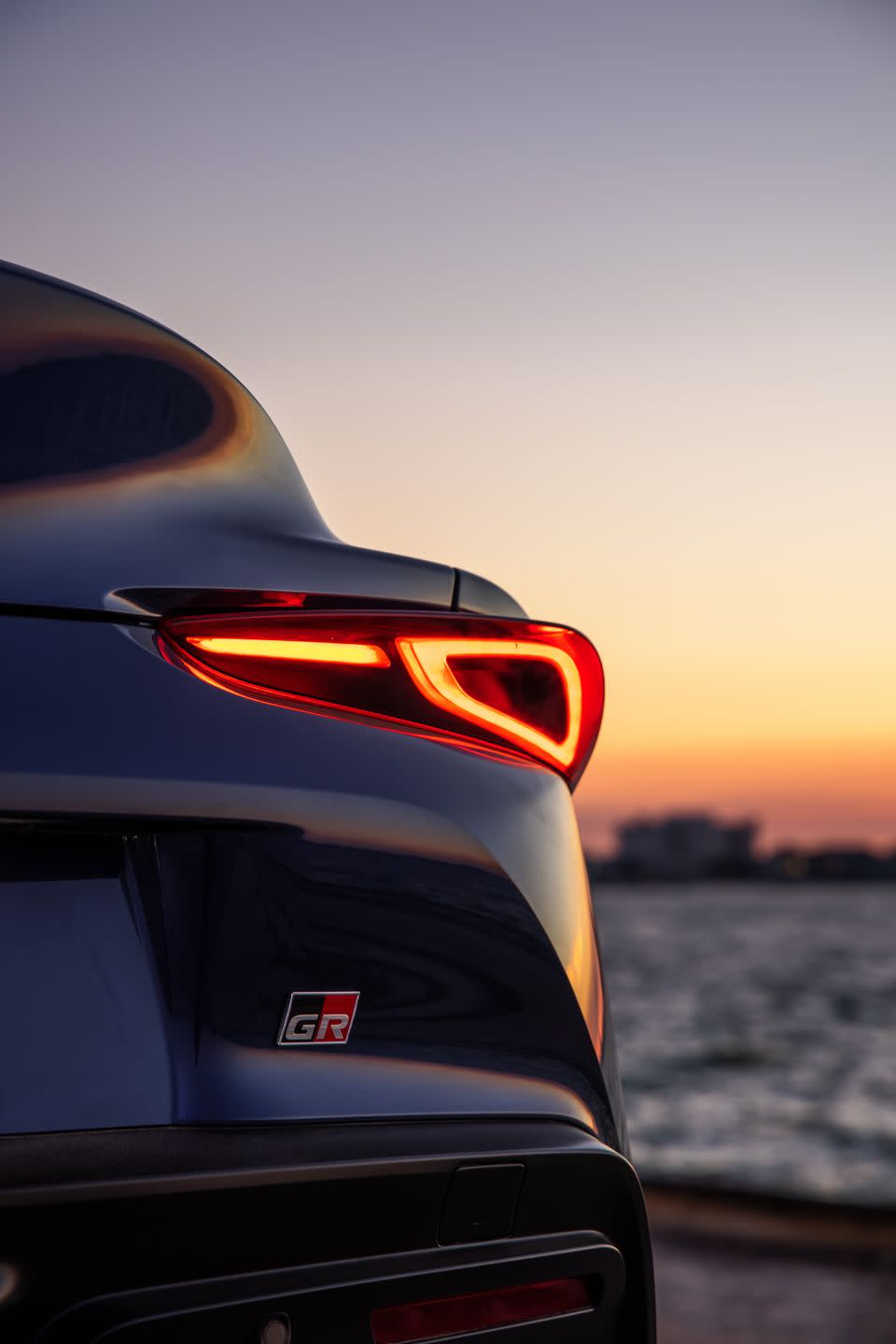
Unfortunately, that excellent cold-weather, dry-road performance was of no help when senior editor Joey Capparella hit something—he knows not what—while zipping down an on-ramp near Elizabethtown, Kentucky, on the way to his family home in Nashville, Tennessee. Whatever it was tore a hole in the front passenger-side Sottozero, leaving the tire destroyed, the wheel tweaked, and the Supra immobilized. Supras inherited a BMW trait we don't love: no spare tire.
This led to what we've come to call Joey's Great Roadside-Assistance Debacle, in which it took four hours and seemingly endless phone calls before Toyota's roadside-assistance service arrived with a flatbed and hauled the car to a local dealer. Luckily, a friend trekked two hours from Nashville to pick up Capparella and give him a ride. That was on a Tuesday, and it took from then until the following Monday for a replacement Sottozero to arrive at the dealer (we said they were rare), where it was installed on the dinged-but-still-safe front wheel. The tire and installation cost us a steep $409. Once back home, we had the wheel straightened for $135. "I never want to drive this car again," Capparella wrote in the Supra's logbook in a fit of pique.
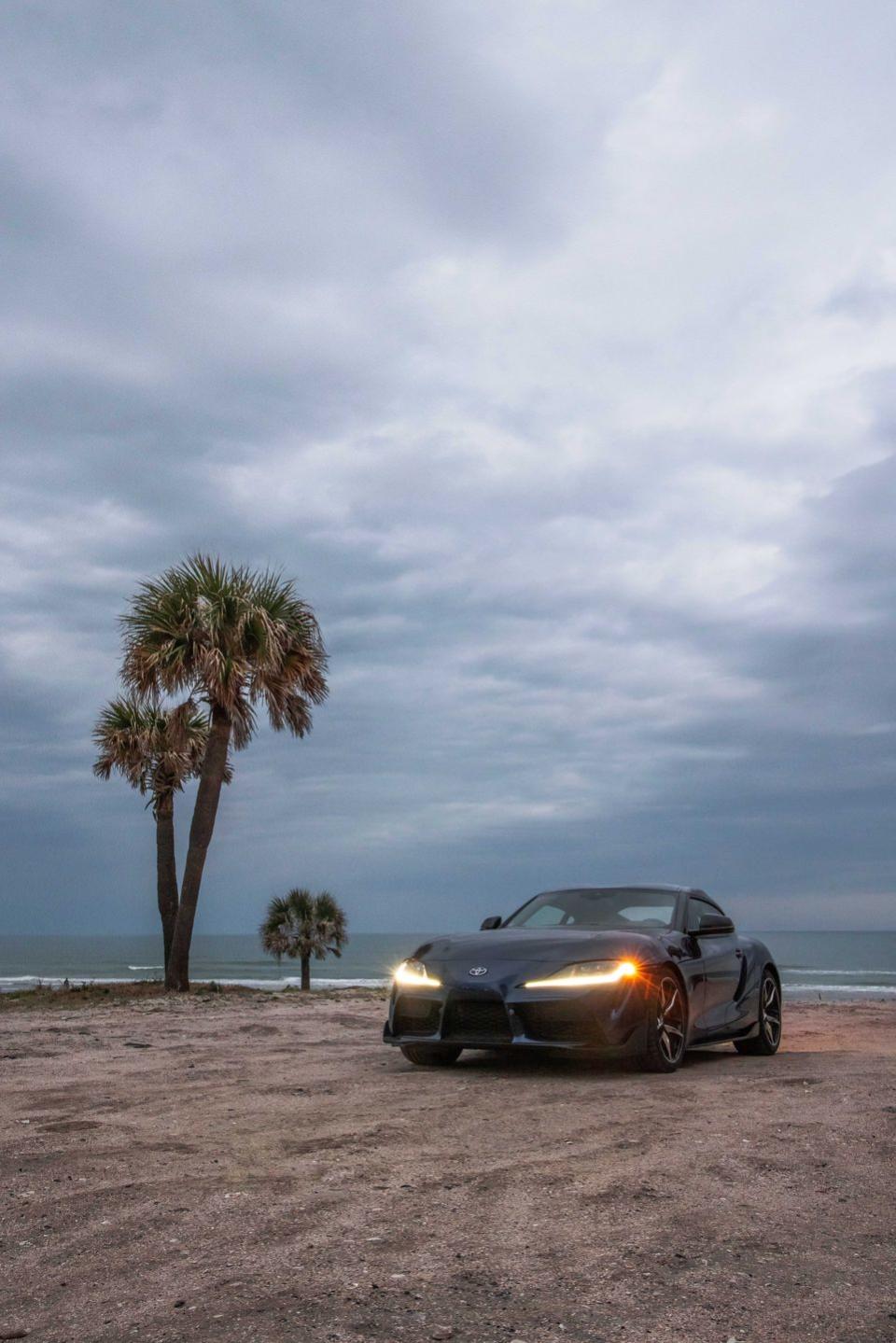
Which is fine, because that means more time behind the Supra's wheel for the rest of us. Driving this car in its element remains a pure joy. And its anvil-like reliability does nothing but increase our affection for it. Aside from the cost of fuel, all we've spent on our Downshift Blue long-termer since its 10,000-mile update is the cost of the replacement Pirelli and the wheel repair. It hasn't required so much as an oil change. Its day-to-day reliability has been thoroughly, well, Toyota-like, which is especially good seeing as how its mechanicals are entirely from BMW, shared with that company's Z4 roadster.
The Supra's poor performance in snow, however, has us thinking that it's best considered a three-season car for those who live in the Snowbelt. But those three seasons of driving surely will be special. Which is why we think Capparella will be back behind the Supra's wheel sooner rather than later.
Months in Fleet: 14 Current Mileage: 21,518
Average Fuel Economy: 25 mpg
Fuel Tank Size: 13.7 gal Observed Fuel Range: 342 miles
Service: $210 Normal Wear: $0 Repair: $0
Damage and Destruction: $544
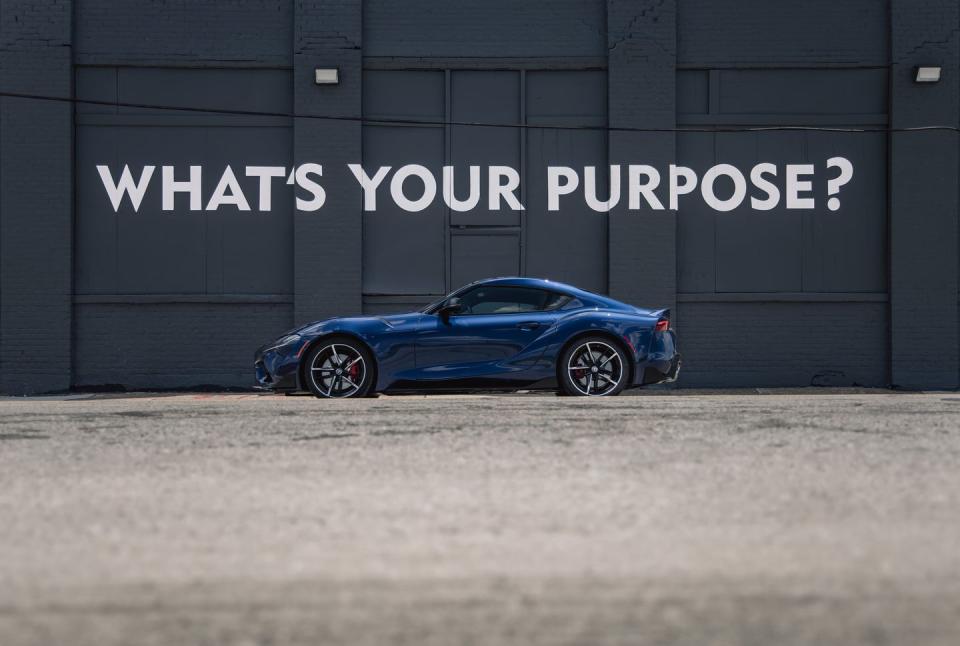
10,000-Mile Update
We've been driving our Toyota Supra 3.0 for eight months and 10,811 miles, and in that time we've learned something about it that no amount of track testing or comparison test battles could have predicted: that it would have instant street cred. For many people, our Downshift Blue Supra was the first they'd ever seen—Toyota has sold only 3798 through September—and it continually draws admiring looks, lustful glances, and a steady stream of "oohs" and "what's that?" In the court of public opinion, it's one killer sports car. We couldn't agree more.
Manufacturers build cars like the Supra in part to cast a halo over the rest of their lineup—they're actually called halo cars in industry parlance—and to burnish the reputation of the parent company that makes them. The Supra is doing exactly that. As Exhibit A, we offer some observations that our staffers have penned in the Supra's logbook.
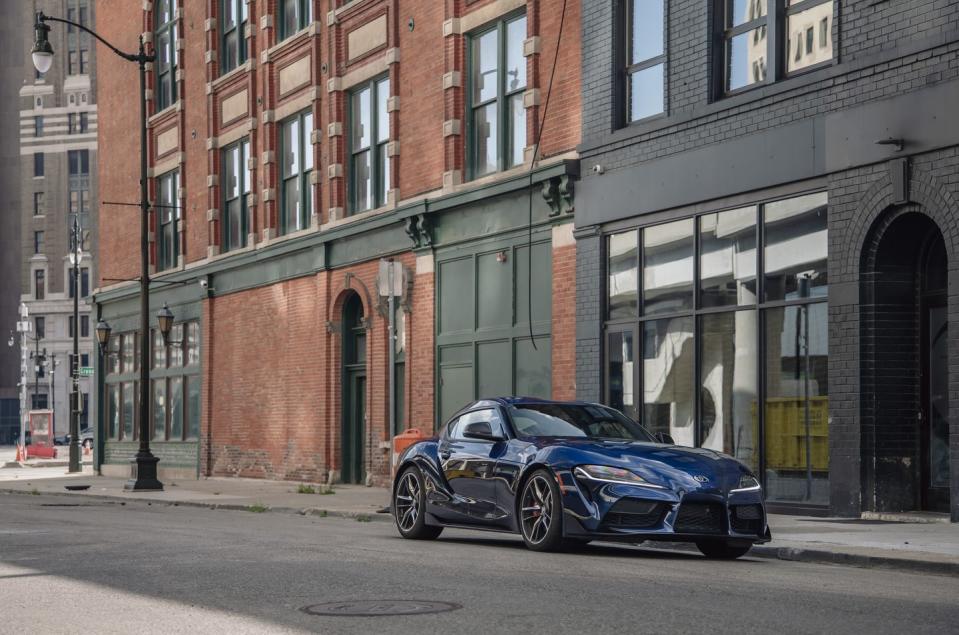
"A man in a Honda Fit followed me to a Jimmy John's drive-through," wrote staff editor Austin Irwin, "parked, and walked over and asked to take a photo of the car. Another guy flagged me down at a Taco Bell to tell me his brother had a Supra from the 1990s." (Eating a lot of fast food these days, Austin?—Ed.) Then there was the robotics engineer who circled the Supra in yet another parking lot and exclaimed, "You bastards. You got the new Supra. Seeing this car, I'm going to buy one."
After driving the Supra for a two-week span, editorial operations manager Juli Burke reported, "I got a lot of long, longing looks from car fans." Print director Eric Tingwall observed, "This car attracts constant attention from males ages eight to 40. They all know it's a Toyota Supra, they think it's cool, and those who are aware that BMW builds it could not care less about its origins." He added, "The Supra appears to be rehabbing Toyota's beige reputation far more successfully than the Scion FR-S/Toyota 86. This is a halo car doing exactly what halo cars are supposed to do."
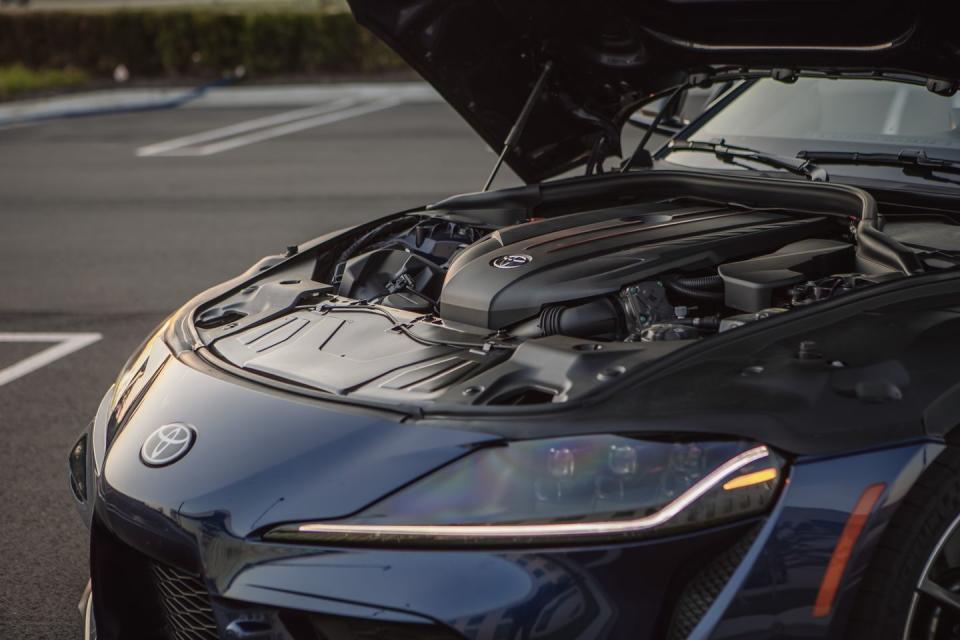
Indeed, what the citizenry inferred from the Supra's muscle-bound sheetmetal is exactly what it's been delivering from behind the wheel. We've already reported on its ripping performance—60 mph in 3.7 seconds and 1.05 g of skidpad grip. Speed and handling would never be an issue; what we wanted to know was what it was like to live with.
So far, so good. Our first 10,000 miles were accumulated virtually all within Michigan's borders thanks to COVID-19 concerns. But ours is a big state, and our drivers crisscrossed it multiple times visiting the burgs of Gaylord, Oscoda, South Haven, and the famous Warren Dunes State Park in Sawyer. We used it for weekend getaways as well as for daily commutes and grocery-store runs.
But nothing we did with it dulled its shine. Our admiration starts with the BMW-sourced turbocharged 3.0-liter inline-six, which propels our 2020 model like it has more than the claimed 335 horses. The 2021 models receive a bump to 382 horsepower. And we confirmed our car's status as an overachiever with a chassis dynamometer test. "I hope BMW charged Toyota a lot of money for this engine," said director of vehicle testing Dave VanderWerp, "because it's one of the greats." Assistant technical editor Max Mortimer added, "I love how rowdy and pure the exhaust note is." Nail the throttle at 10 mph and the Supra lights up its rear tires, the engine lunges for the 7000-rpm redline, and the exhaust blats out the howl of a thousand angry bloodhounds.

But hit the highway and the Supra settles down to a civilized cruise. "It did surprisingly well on a 600-mile weekend road trip," said VanderWerp. "Highway ride is very reasonable, and the tires only get really noisy over the rare concrete sections." Irwin added: "I love the seating position, low like a race car but within reach of the controls. Drive anything else after a week in the Supra, and you'll feel like a substitute bus driver."
On longer trips, the Supra surprised us with how parsimonious it was with fuel. During VanderWerp's weekend getaway to Michigan's northern regions, he noted, "Even when cruising at 80 mph, the trip computer was showing 35 mpg. Amazing." And despite our heavy-footed treatment in local driving, the Supra's average fuel economy to date is 24 mpg.
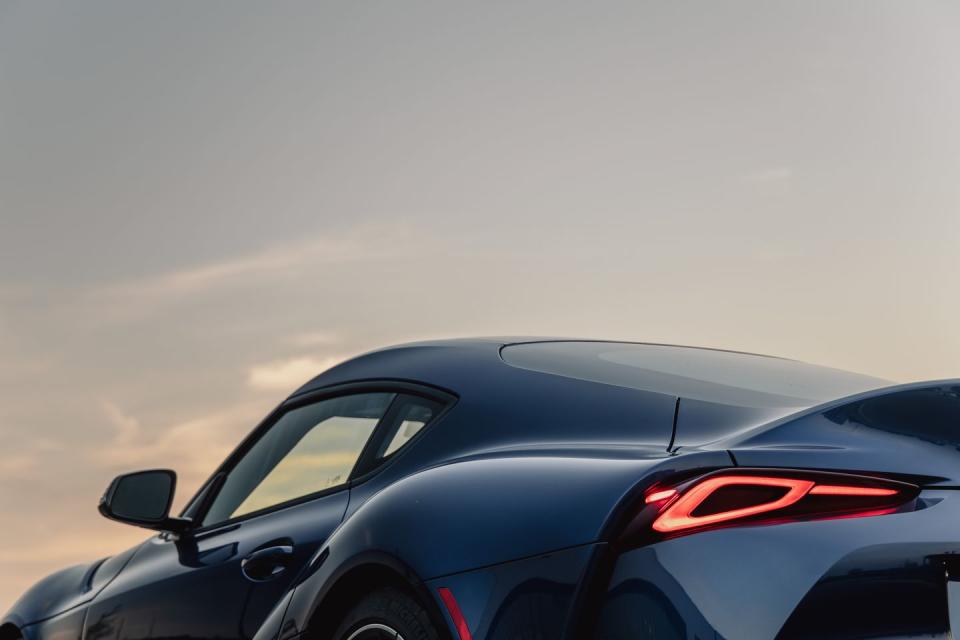
Inevitably, spending months with any car brings its weak points into focus, and the Supra has several. There has been no agreement on seat comfort. Our tallest driver liked the leather-covered buckets just fine, while an average-sized driver complained of the fit. But both agreed that the Supra's sexy styling, with its low roof and slits for windows, hurt visibility to all sides and made traffic lights hard to see without scrunching down in the seat. Its down-low proportions had even our youngest and most limber staffers complaining about how awkward it is to climb in and out of.
And don't even try to drive it with the windows down. Something about the Supra's bulging shape creates buffeting inside the cabin so vicious that by 55 mph your left hand involuntarily reaches for the window switches. "Heartbreaking," Irwin said. "I want to hear all of the exhaust sound and feel the wind rush." We'd also like more interior storage space, an exterior release button for the rear hatch, and a fuel gauge with markings that are easier to decipher. But really, everyone who cites a complaint about the Supra ends up saying how much they like it nonetheless.
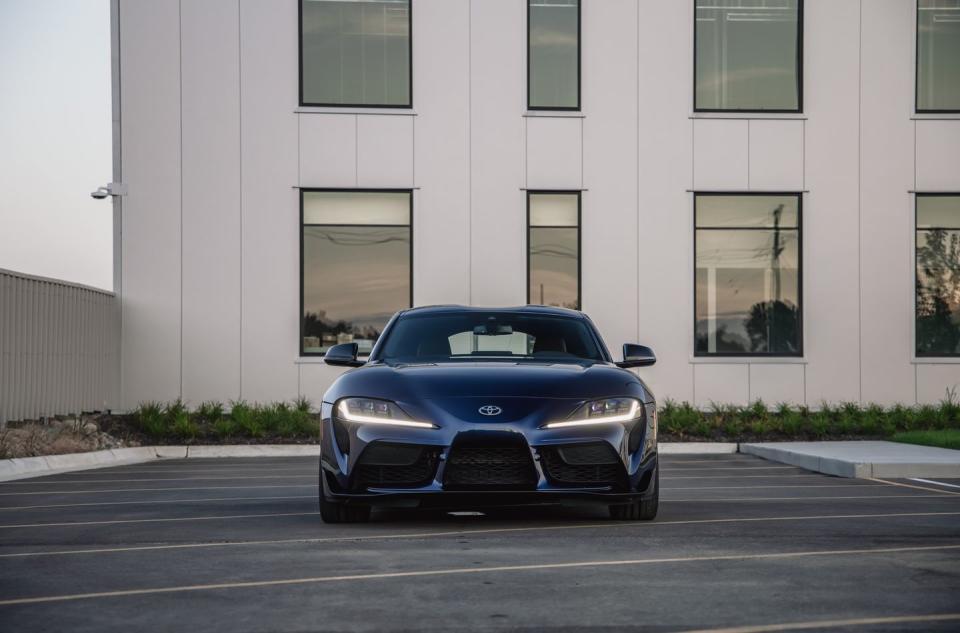
We started this test wondering if a car jointly developed by two companies with very different engineering philosophies would introduce reliability issues that neither would have had if they built the car alone. If the first 10,000 miles are any indication, the answer is no. The Supra's service record has been as impeccable as we'd hope for if it were a Camry. It just received its first required service, an oil-and-filter change and a multipoint inspection, that cost $210. Beyond that, it has spent zero time at the dealer for unscheduled maintenance.
We couldn't be happier with it as we continue to pile on the miles. Time stuck in the shop means less time on the road. And no one around here wants to miss a chance to wrap their hands around the Supra's steering wheel and revel in its straight-six's joyful shouts.
Months in Fleet: 8 months Current Mileage: 10,811 miles
Average Fuel Economy: 24 mpg
Fuel Tank Size: 13.7 gal Observed Fuel Range: 320 miles
Service:$210 Normal Wear: $0 Repair: $0
Damage and Destruction: $0
Introduction
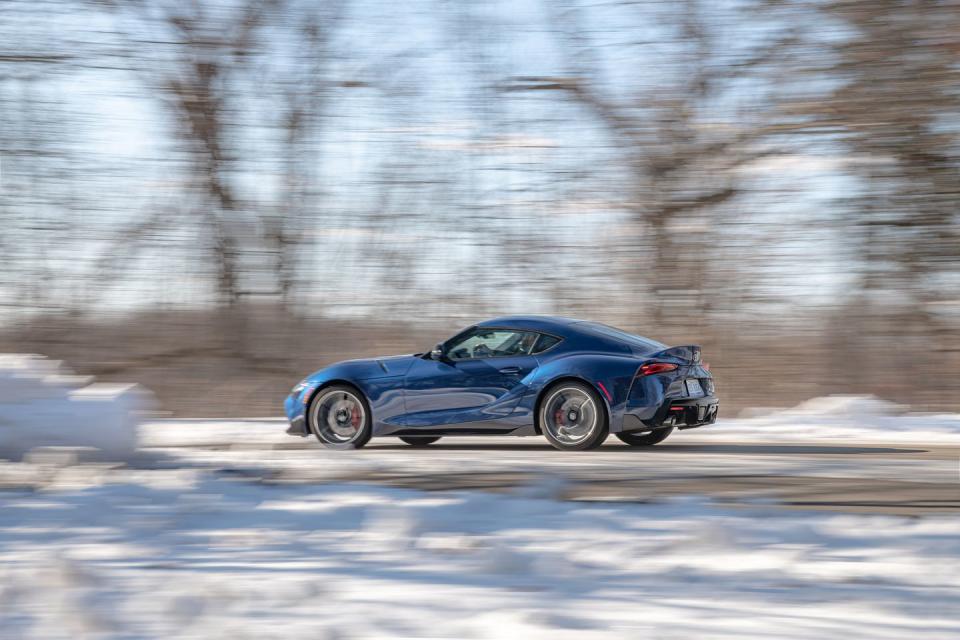
We are not putting the new Toyota Supra though a 40,000-mile long-term test to explore how we feel about it. We already know that it's quite good and that we like it a lot. To see how deep our respect for this killer two-seater goes, just follow the editorial breadcrumbs that we've dropped over the past year or so.
We heaped praise on the Supra the first time we drove it. We thought it was hot enough to pit against the BMW M2, Ford Mustang Shelby GT350, and Porsche 718 Cayman in a comparison test—and then against a BMW Z4 roadster in another shootout. It was so quick in our testing that we strapped it to a chassis dyno to verify its horsepower rating, which turned out to be more than Toyota claimed. We pushed it to the limit in our 2019 Lightning Lap track event, where it impressed. And then we gave it a 10Best award, the highest honor we can bestow on a new vehicle. Now we're filling in the missing part of the picture: how this brilliant sports car holds up to the daily grind.
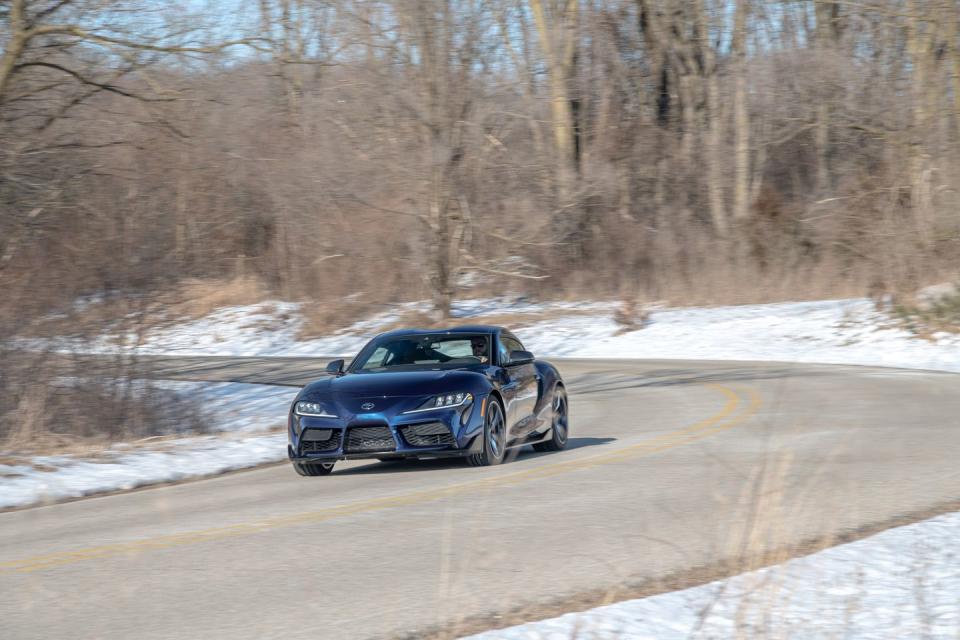
There's a reason for our heightened curiosity about the Supra's long-term dependability. Toyotas have a reputation for being impossible to kill, but this is not your average Toyota. It's a mixed breed—part BMW, part Toyota. Toyota leveraged BMW on the Supra project, borrowing what it could from the Z4, much to the dismay of committed fanboys of previous-generation Supras, who wanted the new one to again be pure Toyota.
Whenever two companies with two different engineering cultures attempt to integrate their components and technologies, the door opens to potential glitches. Would this joint-venture car start showing issues somewhere down the figurative and literal road? That's what we're going to find out.
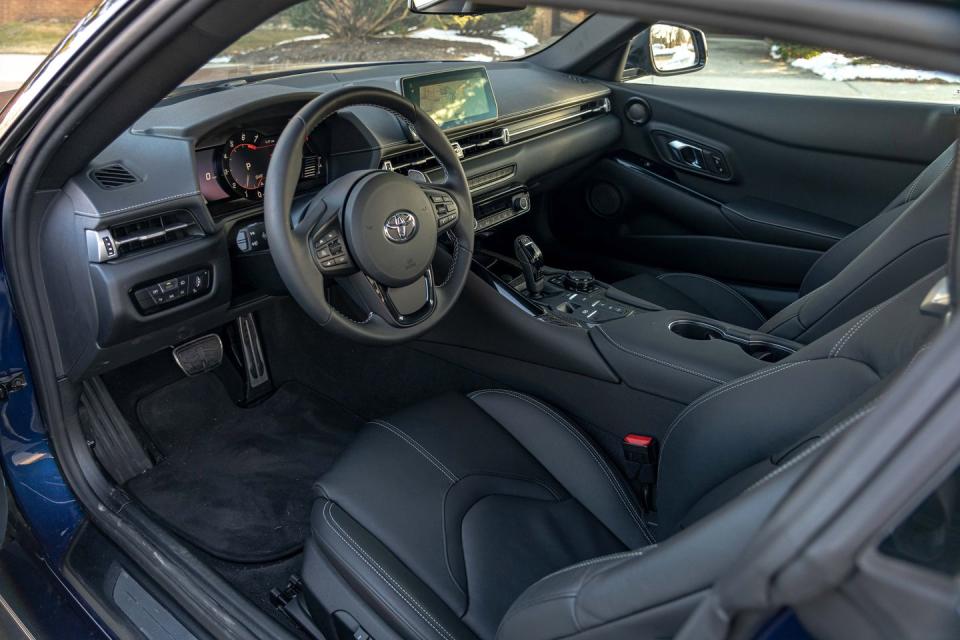
Mechanically, the Supra is more BMW than Toyota. Okay, maybe it's all BMW. Its turbocharged B58 3.0-liter inline-six, ZF eight-speed automatic transmission, electronically controlled limited-slip differential, steering rack, and suspension components are from BMW—the same basic pieces employed in the Z4 M40i. For 2020, Supras are fitted with a 335-hp version of the B58 inline-six, while the Z4 M40i launched with 382 horsepower. For 2021, Supras will get that higher-output engine tune as well.
Inside the Supra's tomb-dark cabin, you'll find more BMW gear, including the German company's electronic shifter, infotainment controls, and audio switches. Toyota was responsible for the Supra's exterior and interior design, the engineering of its body shell, and how its ride and handling was tuned. But the biggest difference between the two cars is that the Supra is a hatchback and the Z4 only comes as a convertible.

Our Downshift Blue Supra is the mid-grade GR (Gazoo Racing) 3.0 Premium model. Thanks to a full helping of standard comfort and convenience features, it's as much a grand tourer as it is a sports car. Its goodies include heated, 14-way power-adjustable seats covered in black leather; a head-up display; an 8.8-inch touchscreen infotainment system with navigation; automatic climate control; and a 12-speaker JBL audio system. Pre-collision automatic braking with pedestrian detection and lane-keeping assist are standard. To that we added just one major option: the Driver Assist package, which brings adaptive cruise control, blind-spot monitoring, and rear cross-traffic alert with emergency braking. A carpeted rear cargo mat and wheel locks brought the $54,945 base price to $56,285.
When our car arrived in mid-February, we attempted to fit it with a set of winter tires. It was virtually impossible to find a single source that could provide a matched set of high-performance winters in the Supra's size—255/35R-19 in front, 275/35R-19 at the rear. Enter Pirelli, who graciously pulled together a special set of Sottozero Serie II's for us in the correct sizes. "These are the most performance-oriented, street-legal winter tires available," Pirelli claims. Indeed, the fronts are designed for the Lamborghini Aventador, while the rears are intended for the Aston Martin DB9. Who drives their Lambo or Aston in the snow? We want to meet these people. We ultimately found that, between Tire Rack and Summit Racing, you could piece together a similar set for $1350.
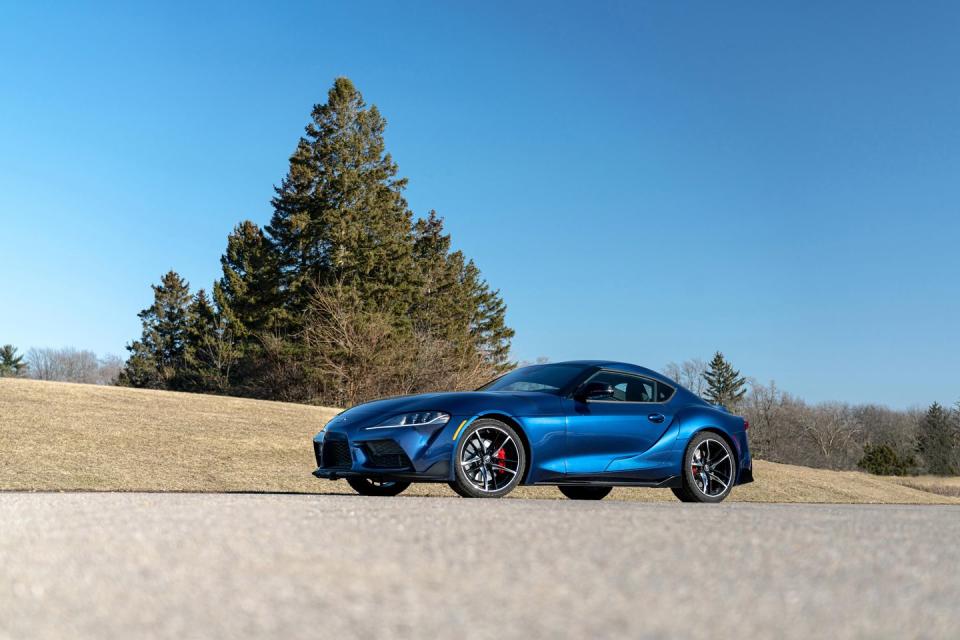
Once set up with the proper footwear for foul midwestern winter weather, we eased the Supra through its 1200-mile break-in period, during which time engine revs are supposed to be kept below 4500 rpm and the vehicle below 100 mph—both surprisingly hard to do in a car this swift. With its factory Michelin Pilot Super Sport summer tires reinstalled for its initial outing at the test track, we once again witnessed performance that puts the Supra in the company of some serious high-performance machinery.
Our 3388-pound test car rocketed to 60 mph in just 3.7 seconds and through the quarter mile in 12.2 seconds at 113 mph. It circulated the skidpad at 1.05 g and stopped from 70 mph in 148 feet. Technical editor David Beard reported that it orbited the 300-foot skidpad with its rear end sliding as much as any car he's ever tested. We experienced the same tail-happy tendency in our previous tests, during flat-out laps at Virginia International Raceway (VIR), and on our favorite on-ramps on the winter tires. It's part of what makes the Supra feel exciting and on edge when driven hard. But as print director Eric Tingwall said of his laps in the car around VIR, "It can be a bit much." Toyota revised the Supra's suspension tuning for 2021, and we look forward to seeing if those changes make its rear end less prone to stepping out.

That particular behavior is something you'll only see when pushing the Supra to its limits. In normal driving, it's sweet, encouraging, and fun. It rides well enough to be a long-distance cruiser. It's agile enough to be fun anytime the road squirms. It's fast enough to make you laugh every time you nail the throttle. The BMW six-cylinder sounds fantastic. And its weird-science styling garners plenty of attention. In short, the Supra makes you feel good. Now we'll see if its maintenance requirements and day-to-day livability break that spell or enhance it.
Months in Fleet: 1 month Current Mileage: 1,798 miles
Average Fuel Economy: 23 mpg
Fuel Tank Size: 13.7 gal Observed Fuel Range: 310 miles
Service: $0 Normal Wear: $0 Repair: $0
Damage and Destruction: $0
You Might Also Like
